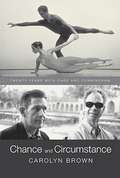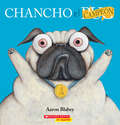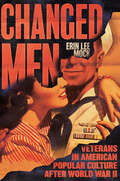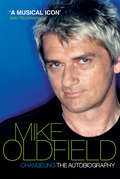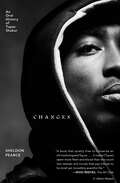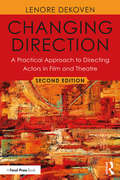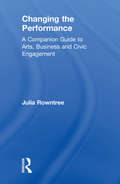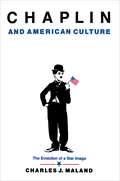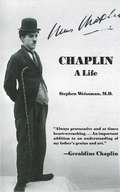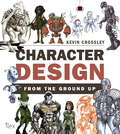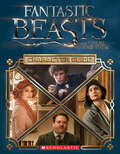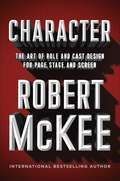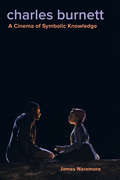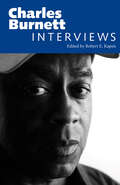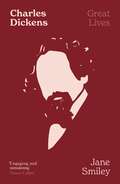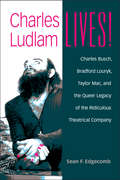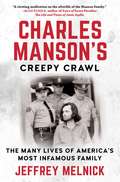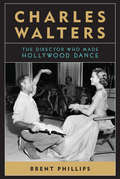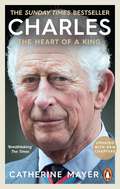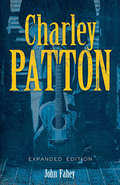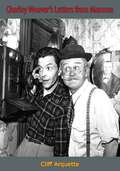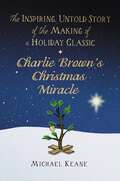- Table View
- List View
Chance and Circumstance: Twenty Years with Cage and Cunningham
by Carolyn BrownThe long-awaited memoir from one of the most celebrated modern dancers of the past fifty years: the story of her own remarkable career, of the formative years of the Merce Cunningham Dance Company, and of the two brilliant, iconoclastic, and forward-thinking artists at its center--Merce Cunningham and John Cage. From its inception in the l950s until her departure in the l970s, Carolyn Brown was a major dancer in the Cunningham company and part of the vibrant artistic community of downtown New York City out of which it grew. She writes about embarking on her career with Cunningham at a time when he was a celebrated performer but a virtually unknown choreographer. She describes the heady exhilaration--and dire financial straits--of the company's early days, when composer Cage was musical director and Robert Rauschenberg designed lighting, sets and costumes; and of the struggle for acceptance of their controversial, avant-garde dance. With unique insight, she explores Cunningham's technique, choreography, and experimentation with compositional procedures influenced by Cage. And she probes the personalities of these two men: the reticent, moody, often secretive Cunningham, and the effusive, fun-loving, enthusiastic Cage. Chance and Circumstance is an intimate chronicle of a crucial era in modern dance, and a revelation of the intersection of the worlds of art, music, dance, and theater that is Merce Cunningham's extraordinary hallmark.
Chancho el campeón (Chancho el pug)
by Aaron BlabeyThe world's greediest pug won't play fair, and he'll do just about anything to win!The Spanish edition of Pig the Winner!Will Pig ever learn? He's an absolute cheat and quite the sore loser as well. But when Pig challenges his foot-long playmate, Trevor, to a kibble eating contest, he accidentally stuffs more than just food in his mouth. Lucky for Pig, Trevor knows what to do and saves the day!Young readers will love Blabey's irresistibly quirky illustrations that are paired with a relatable lesson about learning to play nice. For dog and pet lovers everywhere.¿Aprendera Chancho alguna vez? Es un tramposo y un mal perdedor. Pero, cuando Chancho reta a Tomas a ver quien come mas, accidentalmente termina metiendose algo mas que comida en la boca. Por suerte para Chancho, ¡Tomas sabe que hacer!A los jovenes lectores les encantaran las extravagantes e irresistibles ilustraciones de Blabey que acompanan esta leccion sobre ser amables a la hora de jugar. Para los amantes de los animales en todos los lugares.
Changed Men: Veterans in American Popular Culture after World War II (Cultural Frames, Framing Culture)
by Erin Lee MockPostwar culture and anxiety over the reintegration of veterans into American society Millions of GIs returned from overseas in 1945. A generation of men who had left their families and had learned to kill and to quickly dispatch sexual urges were rapidly reintegrated into civilian life, told to put the war behind them with cheer and confidence. Many veterans struggled, openly or privately, with this transition. Others in society wondered what the war had wrought in them. As Erin Lee Mock shows in this insightful book, the &“explosive&” potential of men became a central concern of postwar American culture. This wariness of veterans settled into a generalized anxiety over men&’s &“inherent&” violence and hypersexuality, which increasingly came to define masculinity. Changed Men engages with studies of film, media, literature, and gender and sexuality to advance a new perspective on the artistic and cultural output of and about the &“Greatest Generation,&” arguing that depictions of men&’s violent and erotic potential emerged differently in different forms and genres but nonetheless permeated American culture in these years. Viewing this homecoming through the lenses of war and trauma, classical Hollywood, pulp fiction, periodical culture, and early television, Mock shows this history in a provocative new light.
Changeling: The Autobiography of Mike Oldfield
by Mike OldfieldBorn without social instincts many people take for granted, brought up in a troubled environment and possessed with an extraordinary musical talent, Mike Oldfield was thrust into the spotlight at the tender age of nineteen. His first album Tubular Bells went on to sell fifteen million copies worldwide and catapulted him into a stardom he was ill-equipped to cope with.From growing up with an alcoholic mother, to his feelings of alienation and struggles with depression, this book takes Mike from his early years, through his staggering fame, his broken marriages, years as a recluse, his rebirth experience at a controversial Exegesis seminar and beyond. Mike Oldfield has been on a journey few of us could ever imagine, and offers a message of hope to anybody who feels they live on the edge of society.
Changes: An Oral History of Tupac Shakur
by Sheldon PearceA New Yorker writer&’s intimate, revealing account of Tupac Shakur&’s life and legacy, timed to the fiftieth anniversary of his birth and twenty-fifth anniversary of his death.In the summer of 2020, Tupac Shakur&’s single &“Changes&” became an anthem for the worldwide protests against the murder of George Floyd. The song became so popular, in fact, it was vaulted back onto the iTunes charts more than twenty years after its release—making it clear that Tupac&’s music and the way it addresses systemic racism, police brutality, mass incarceration, income inequality, and a failing education system is just as important now as it was back then. In Changes, published to coincide with the fiftieth anniversary of Tupac&’s birth and twenty-fifth anniversary of his death, Sheldon Pearce offers one of the most thoughtful and comprehensive accounts yet of the artist&’s life and legacy. Pearce, an editor and writer at The New Yorker, interviews dozens who knew Tupac throughout various phases of his life. While there are plenty of bold-faced names, the book focuses on the individuals who are lesser known and offer fresh stories and rare insight. Among these are the actor who costarred with him in a Harlem production of A Raisin in the Sun when he was twelve years old, the high school drama teacher who recognized and nurtured his talent, the music industry veteran who helped him develop a nonprofit devoted to helping young artists, the Death Row Records executive who has never before spoken on the record, and dozens of others. Meticulously woven together by Pearce, their voices combine to portray Tupac in all his complexity and contradiction. This remarkable book illustrates not only how he changed during his brief twenty-five years on this planet, but how he forever changed the world.
Changing Direction: Foreword by Ang Lee
by Lenore DeKovenThe second edition of this elegant and accessible primer offers a helpful reference and resource for directing actors in film, television, and theatre, useful to directors, actors, and writers. Combining underlying theory with dozens of exercises designed to reveal the actor's craft, Lenore DeKoven discusses constructing the throughline; analyzing the script; character needs; the casting and rehearsal processes; as well as the actor and the camera. Distilling difficult concepts to their simplest form, DeKoven explains how to accurately capture and portray human behavior on stage and screen, offering creative solutions to issues she has encountered or anticipated after decades of experience. Excerpts from interviews with acclaimed actors offer insight into their work with directors, what inspires them, and what they really want from the director. This second edition incorporates the film Moonlight (2016, Barry Jenkins) for analysis of the directing concepts discussed.
Changing Journalism (Communication and Society)
by Tamara Witschge Angela Phillips Peter Lee-WrightJournalism is in transition. Irrevocable decisions are being made, often based on flimsy evidence, which could change not only the future of journalism, but also the future of democracy. This book, based on extensive research, provides the opportunity to reflect upon these decisions and considers how journalism could change for the better and for the good of democracy. It covers: the business landscape work and employment the regulatory framework audiences and interaction the impact of technology on practices and content ethics in a converged world The book analyses research in both national and local journalism, broadcast, newspaper and online journalism, broadsheet and tabloid, drawing comparisons between the different outlets in the field of news journalism, making this essential reading for scholars and students of journalism and media studies.
Changing Shoes
by Tina SloanA beloved daytime TV actress tackles the real-world issues women face at different times of their life through the various shoes (and roles) they wear. You might be wondering what wisdom and life lessons a soap opera actress, dispatched from the land of outrageous and hilarious plots, has to offer. Well, no one knows more about reinvention and perseverance than an actress who began her career as the star of a show-and then became the mother of the star, and then the grandmother of the star-all while raising a son, taking care of her aging parents, and sustaining a happy marriage. In Changing Shoes, Tina Sloan tells her story through humorous anecdotes about the shoes she has worn throughout her personal and professional life (from her college-girl pink Capezios to her first pair of Chanel pumps, to her white high heels and fitted nurse's uniform, to old sneakers and modern nurse's scrubs). Sloan imparts warm, relatable advice to which all women can relate, including looks, love lives and sexuality, careers, families, and sense of self. .
Changing the Performance: A Companion Guide to Arts, Business and Civic Engagement
by Julia RowntreeA result of many years of research and practice, Changing the Performance is a book about the arts and about business, and the interplay between the two. Julia Rowntree gives a fascinating account of her experiences forging the business sponsorship campaign at the London International Festival of Theatre (LIFT). Raising intriguing questions, this book proposes that fundraising for the arts is much more than simply a function for generating income. It fulfils an ancient social role of connection across levels of power, expertise, culture, gender and generation. Rowntree describes why these dynamics are vital to society's ability to adapt. Changing the Performance is an inspiring manual for arts practitioners concerned with the relationship between business, the arts and wider society, and particularly those engaged in fundraising.
Chaplin and American Culture: The Evolution of a Star Image
by Charles J. MalandCharles Maland focuses on the cultural sources of the on-and-off, love-hate affair between Chaplin and the American public that was perhaps the stormiest in American stardom.
Chaplin: A Life
by Stephen Weissman"Chaplin is arguably the single most important artist produced by the cinema," wrote film critic Andrew Sarris. Born in London in 1889, Charlie Chaplin grew up in dire poverty. Severe alcoholism cut short his father's flourishing career, and his beloved mother first lost her voice, then her mind, to syphilis. How did this poor, lonely child, committed to the Hanwell School for the Orphaned and Destitute, become such an extraordinary comedian, known and celebrated worldwide? Dr. Stephen M. Weissman brilliantly illuminates both the screen legend himself and the turbulent era that shaped him.
Character Design from the Ground Up: Make Your Sketches Come To Life
by Kevin CrossleyAll stories have characters, and whether its a film, game, book, or comic, all characters need to be designed. Character design has become a distinct discipline in the entertainment industry, and character designers are employed by film and game companies across the globe to bring life to scripts and ideas. In this book, illustrator and character designer Kevin Crossley provides a complete overview of character design. Starting with the basics of materials, equipment, and sofware, Kevin will explain the processes professional character designers follow to develop characters for publishing, games, and film. From ideas and thumbnails, anatomy and reference, through effective drawing, 3D mock-ups and full turnarounds, Kev explains how a character designer works to achieve professional results.
Character Design from the Ground Up: Make Your Sketches Come To Life
by Kevin CrossleyAll stories have characters, and whether its a film, game, book, or comic, all characters need to be designed. Character design has become a distinct discipline in the entertainment industry, and character designers are employed by film and game companies across the globe to bring life to scripts and ideas. In this book, illustrator and character designer Kevin Crossley provides a complete overview of character design. Starting with the basics of materials, equipment, and sofware, Kevin will explain the processes professional character designers follow to develop characters for publishing, games, and film. From ideas and thumbnails, anatomy and reference, through effective drawing, 3D mock-ups and full turnarounds, Kev explains how a character designer works to achieve professional results.
Character Guide (Fantastic Beasts and Where to Find Them)
by Michael KoggeMeet Newt, Tina, Queenie, Jacob, and many more in this comprehensive character guide to Fantastic Beasts and Where to Find Them!Following a magical mix-up, British Magizoologist Newt Scamander unwittingly finds himself on a chase around New York City looking for magical beasts. To set things right, Newt has to track down his escaped magical creatures with the help of aspiring baker Jacob Kowalski, as well as Tina and Queenie Goldstein, two witches who work for the Magical Congress of the United States of America. This chance meeting of characters leads to an action-packed adventure Newt won't soon forget.
Character: The Art of Role and Cast Design for Page, Stage, and Screen
by Robert MckeeThe long-awaited third volume of Robert McKee&’s trilogy on the art of fiction. Following up his perennially bestselling writers' guide Story and his inspiring exploration of the art of verbal action in Dialogue, the most sought-after expert in the storytelling brings his insights to the creation of compelling characters and the design of their casts. CHARACTER explores the design of a character universe: The dimensionality, complexity and arcing of a protagonist, the invention of orbiting major characters, all encircled by a cast of service and supporting roles.
Charles Burnett: A Cinema of Symbolic Knowledge
by James NaremoreIn the first book devoted to Charles Burnett, a crucial figure in the history of American cinema often regarded as the most influential member of the L.A. Rebellion group of African American filmmakers, James Naremore provides a close critical study of all Burnett’s major pictures for movies and television, including Killer of Sheep, To Sleep with Anger, The Glass Shield, Nightjohn, The Wedding, Nat Turner: A Troublesome Property, and Warming by the Devil’s Fire. Having accessed new information and rarely seen material, Naremore shows that Burnett’s career has developed against the odds and that his artistry, social criticism, humor, and commitment to what he calls “symbolic knowledge” have given his work enduring value for American culture.
Charles Burnett: Interviews (Conversations with Filmmakers Series)
by Robert E. KapsisCharles Burnett (b. 1944) is a groundbreaking African American filmmaker and one of this country’s finest directors, yet he remains largely unknown. His films, most notably Killer of Sheep (1977) and To Sleep with Anger (1990), are considered classics, yet few filmgoers have seen them or heard of Burnett. The interviews in this volume explore this paradox and collectively shed light on the work of a rare film master whose stories bring to the screen the texture and poetry of life in the black community.The best qualities of Burnett’s films-rich characterizations, morally and emotionally complex narratives, and intricately observed tales of African American life-are precisely the things that make his films a tough sell in the mass marketplace. As many of the interviews reveal, Hollywood has been largely inept in responding to this marketing challenge. “It takes an extraordinary effort to keep going,” Burnett told Terrence Rafferty in 2001, “when everybody’s saying to you, ‘No one wants to see that kind of movie,’ or ‘There’s no black audience.’” All the interviews selected for this volume—spanning more than three decades of Burnett’s directorial career, including his recent work—examine, in various degrees, Burnett’s status as a true independent filmmaker and explore his motivation for making films that chronicle the black experience in America.
Charles Dickens (LIVES #4)
by Jane SmileySuperb, highly accessible biography of one of the giants of English literature by the Pulitzer Prize-winning author of A THOUSAND ACRES'Engaging and stimulating' Simon Callow'Jane Smiley, in her admirable contribution to Weidenfeld's series of short biographies, deals briskly with Dickens's career and works, and treats with sympathy and sense his relations with the women in his life' LITERARY REVIEWFrom a bitter and poverty-stricken childhood to a career as the most acclaimed and best loved writer in the English-speaking world, Charles Dickens had a life as full of incident as any of those he created in his novels of life in Victorian England. The enormous quantity of work, his public readings and his difficult relationships has made him a figure of enduring fascination. In this biography Jane Smiley reveals Charles Dickens as his contemporaries would have done, getting to know him more intimately than ever before. At the same time Smiley offers interpretations of almost all of Dickens' major works, showing how 'his novels shaped his life as much as his life shaped his novels'.
Charles Ludlam Lives!: Charles Busch, Bradford Louryk, Taylor Mac, and the Queer Legacy of the Ridiculous Theatrical Company
by Sean EdgecombPlaywright, actor and director Charles Ludlam (1943–1987) helped to galvanize the Ridiculous style of theater in New York City starting in the 1960s. Decades after his death, his place in the chronicle of American theater has remained constant, but his influence has changed. Although his Ridiculous Theatrical Company shut its doors, the Ludlamesque Ridiculous has continued to thrive and remain a groundbreaking genre, maintaining its relevance and potency by metamorphosing along with changes in the LGBTQ community. Author Sean F. Edgecomb focuses on the neo-Ridiculous artists Charles Busch, Bradford Louryk, and Taylor Mac to trace the connections between Ludlam’s legacy and their performances, using alternative queer models such as kinetic kinship, lateral historiography, and a new approach to camp. Charles Ludlam Lives! demonstrates that the queer legacy of Ludlam is one of distinct transformation—one where artists can reject faithful interpretations in order to move in new interpretive directions.
Charles Manson's Creepy Crawl: The Many Lives of America's Most Infamous Family
by Jeffrey MelnickWith a new epilogue updated from its hardcover edition titled Creepy Crawling: Charles Manson and the Many Lives of America's Most Infamous Family "Creepy crawling" was the Manson Family's practice of secretly entering someone's home, and without harming anyone, leaving only a trace of evidence that they had been there, some reminder that the sanctity of the private home had been breached. Now, author Jeffrey Melnick reveals just how much the Family creepy crawled their way through Los Angeles in the sixties and then on through American social, political, and cultural life for fifty years, firmly lodging themselves in our minds. Even now, it is almost impossible to discuss the sixties, teenage runaways, sexuality, drugs, music, California, or even the concept of family without referencing Manson and his "girls." Not just another Charles Manson history, Charles Manson's Creepy Crawl: The Many Lives of America's Most Infamous Family explores how the Family weren't so much outsiders as emblematic of the Los Angeles counterculture freak scene, and how Manson worked to connect himself to the mainstream of the time. Ever since they spent two nights killing seven residents of Los Angeles—what we now know as the "Tate-LaBianca murders"—the Manson family has rarely slipped from the American radar for long. From Emma Cline's The Girls to the TV show Aquarius, as well as two major films in 2019, including Quentin Tarantino's Once Upon a Time in Hollywood, the family continues to find an audience. What is it about Charles Manson and his family that captivates us still? Author Jeffrey Melnick sets out to answer this question in this fascinating and compulsively readable cultural history of the Family and their influence from 1969 to the present.
Charles Walters: The Director Who Made Hollywood Dance (Screen Classics)
by Brent PhillipsA &“lively biography&” of the director who choreographed Fred Astaire, Debbie Reynolds and more: &“a real backstager&” on the making of Hollywood musicals (Wall Street Journal). From the trolley scene in Meet Me in St. Louis to Fred Astaire and Ginger Rogers's last dance on the silver screen to Judy Garland's tuxedo-clad performance of "Get Happy", Charles Walters staged the iconic musical sequences of Hollywood's golden age. The Academy Award-nominated director and choreographer showcased the talents of stars such as Gene Kelly, Doris Day, and Frank Sinatra—yet Walters's name often goes unrecognized today. In the first full-length biography of Walters, Brent Phillips chronicles the artist's career from his days as a Broadway performer to his successes at Metro-Goldwyn-Mayer. Phillips takes readers behind the scenes of beloved musicals including Easter Parade, Lili, and High Society. He also examines the director's uncredited work on films like Gigi, and discusses his contributions to musical theater and American popular culture. This revealing book also considers Walters's personal life and explores how he navigated the industry as an openly gay man. Drawing on unpublished oral histories, correspondence, and new interviews, this biography offers an entertaining and important new look at an exciting era in Hollywood history.
Charles: The Heart of a King
by Catherine MayerThe Sunday Times Top Ten Bestseller'Breathtaking' The Times'[The book that] made headlines around the world.' IndependentThe former Prince of Wales has lived his whole life in the public eye, yet he remains an enigma. He was born to be king, but he aims much higher. A landmark publication, Charles: The Heart of a King reveals Charles in all his complexity: the passionate views that mean he will never be as remote and impartial as his mother; the compulsion to make a difference and the many and startling ways in which the Prince and now King of the United Kingdom and fifteen other realms has already made his mark.The book offers fresh and fascinating insights into the first marriage that did so much to define him and an assessment of his relationship with the woman he calls, with unintended accuracy, his 'dearest wife': Camilla, now Queen Consort. We see Charles as a father and a friend, a serious figure and a joker. Life at court turns out to be full of hidden dangers and unexpected comedy.Now, updated and revised with a new preface and two new chapters - covering details of Harry and Meghan's exit and its implications, the cash-for-honours scandal, Prince Andrew, and more - this significant study reveals a monarchy threatened and a man in sight of happiness yet still driven by anguish and a remarkable belief system, a charitable entrepreneur, activist, agitator and avatar of the Establishment who just as often tilts against it.Based on multiple interviews with his friends and courtiers, palace insiders and critics, and rare access to Charles himself, before his kingship, this biography explores his philanthropy and his compulsive interventionism, his faith, his significant impact on politics and the philosophy that means when he seeks harmony he sometimes creates controversy.Gripping, at times astonishing, often laugh-out-loud, this is a royal biography unlike any other.'A must-read ... this important book is nothing short of a manual to our future King's world-view' GQ'A sustained piece of higher journalism' Independent
Charley Patton: Expanded Edition
by John FaheyThe Father of the Delta Blues, Charley Patton (1891–1934) was born and raised around Mississippi's cotton plantations. During the 1920s, he was the first of the region's great stars, performing for packed houses throughout the South and making popular recordings in New York City. His music — ranging from blues and ballads to ragtime and gospel — is distinctive for his gravelly, high-energy singing and the propulsive beat of his guitar. Patton had a lively stage presence, originating many of the guitar-playing antics now associated with Jimi Hendrix and other latter-day musicians. His influence, among both his contemporaries and subsequent blues artists, is incalculable. Noted guitarist John Fahey presents a textual and musicological examination of Patton's music. This new edition of the original 1970 publication is enhanced by Fahey's notes from the Grammy-winning, out-of-print box set Screamin' and Hollerin' the Blues: The Worlds of Charley Patton. Available for the first time outside the set, Fahey's reconsideration of Patton's music offers fresh perspectives and key corrections of the historical record.
Charley Weaver’s Letters from Mamma
by Cliff ArquetteFrom coast to coast more people are keeping their television sets on much later, more nights because of Cliff Arquette.A regular on NBC’s “Jack Paar Show” Cliff’s meteoric rise to fame among late evening watchers is the result of his portrayal of a likable old codger Charley Weaver, who hails from Mount Idy, and who reads side-splitting letters from his “Mamma.”These letters are a complete report on the doin’s in the old home town. Through the magic of television, and now the pages of this book, Charley’s “Mamma” has made real people out of Birdie Rodd, Grandpa Ogg, Elsie Krack, Dr. Beemish and all the others. Real people and normal people. Normal except that the darndest things happen to them!As Jack Paar says, “Charley Weaver is a witch. He knows more about comedy than anyone alive, which he isn’t….Old Charley not only gets laughs on a Monday night but he gets them all during Lent…even when we are playing to a convention of Martian undertakers who have just heard bad news. That’s witchcraft!”This book proves Jack Paar’s point.
Charlie Brown's Christmas Miracle: The Inspiring, Untold Story of the Making of a Holiday Classic
by Michael KeaneDiscover the inspiring, unknown, against-all-odds story of how the classic animated holiday special A Charlie Brown Christmas almost never made it on to television. Professor and cultural historian Michael Keane reveals much in this nostalgia-inducing book packed with original research and interviews. Keane compellingly shows that the ultimate broadcast of the Christmas special—given its incredibly tight five-month production schedule and the decidedly unfavorable reception it received by the skeptical network executives who first screened it—was nothing short of a miracle. Keane explains why the show, despite its technical shortcomings, has become an uplifting and enduring triumph embraced by millions of families every Christmas season, even more than fifty years after its premiere. This gripping and joyful behind-the-scenes story of how the creators of A Charlie Brown Christmas struggled to bring the program to life will also help readers (and loyal fans) understand how America&’s favorite Christmas special changed our popular culture forever. Keane masterfully weaves the momentous events of 1965 (the turbulent year of the program&’s production) into his story, providing critical context for a profound new understanding of the program&’s famous climactic scene, Linus&’s spot-lit soliloquy answering the question repeatedly posed by Charlie Brown—"Isn't there anyone who knows what Christmas is all about?&”
